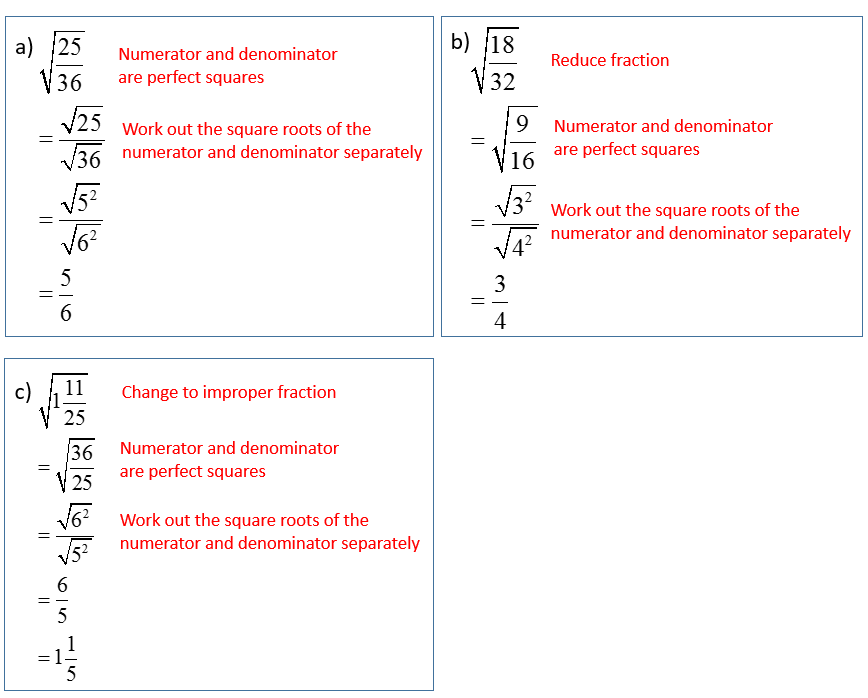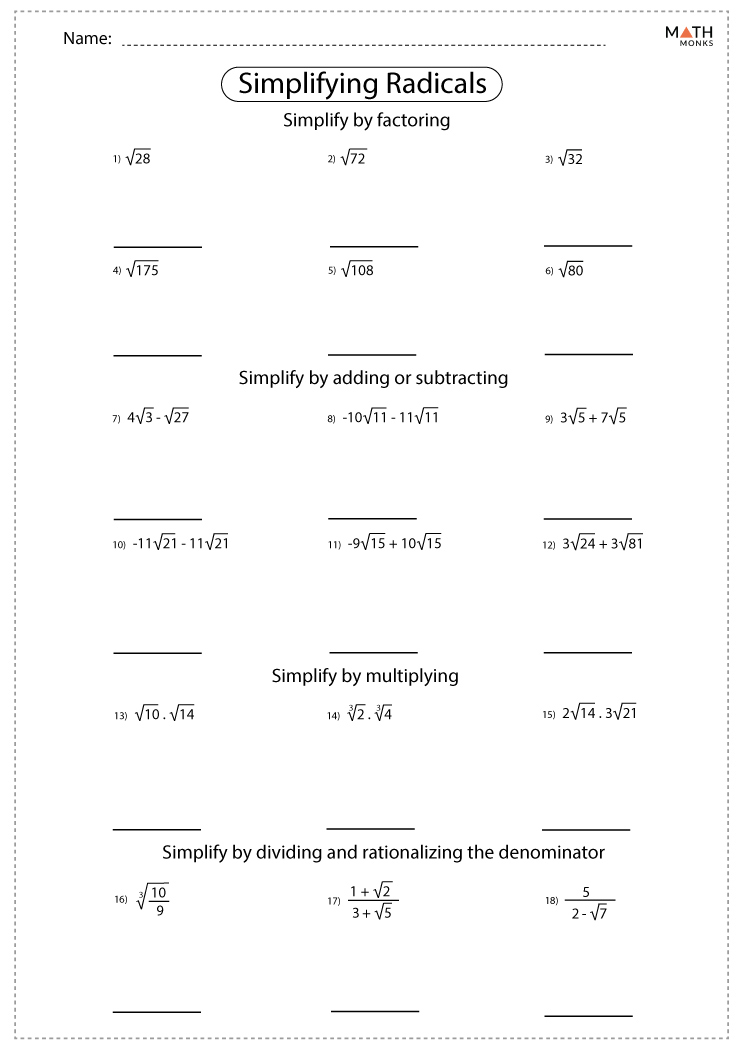Topic square root of 45 simplified radical form: Discover how to simplify the square root of 45 into its radical form with our easy-to-follow guide. This article will help you understand the process step-by-step, ensuring you grasp the concept and apply it confidently in your math problems. Simplifying radicals has never been this straightforward!
Table of Content
- Simplified Radical Form of Square Root of 45
- Introduction to Simplifying Radicals
- Understanding the Square Root of 45
- Prime Factorization Method
- Identifying Perfect Squares
- Simplification Process
- Examples and Practice Problems
- Common Mistakes to Avoid
- Applications in Real Life
- Frequently Asked Questions
- Conclusion and Summary
- YOUTUBE:
Simplified Radical Form of Square Root of 45
The square root of 45 can be simplified by factoring 45 into its prime factors.
Step-by-Step Simplification
- First, factor 45 into its prime factors: \(45 = 3^2 \times 5\).
- Next, identify and separate the perfect square factor: \(45 = 3^2 \times 5\).
- Take the square root of the perfect square factor: \(\sqrt{3^2 \times 5} = \sqrt{3^2} \times \sqrt{5}\).
- Simplify the square root of the perfect square: \(\sqrt{3^2} = 3\).
- Combine the simplified terms: \(3 \times \sqrt{5}\).
Therefore, the simplified radical form of the square root of 45 is:
\[\sqrt{45} = 3\sqrt{5}\]
Summary
The square root of 45, when simplified, is \(3\sqrt{5}\). This process involves factoring the number into its prime factors, identifying the perfect squares, and then simplifying the radical expression.

READ MORE:
Introduction to Simplifying Radicals
Simplifying radicals involves expressing a square root in its simplest form. This process is essential in mathematics to make expressions easier to work with and to understand. Here, we will focus on the square root of 45 and how to simplify it into its radical form.
To simplify a radical, follow these steps:
- Factor the number: Break down the number under the square root into its prime factors. For 45, the prime factorization is \(45 = 3^2 \times 5\).
- Identify perfect squares: Look for perfect square factors within the prime factorization. In this case, \(3^2\) is a perfect square.
- Simplify the square root: Take the square root of the perfect square and multiply it by the square root of the remaining factors. For \( \sqrt{45} \), this becomes \(\sqrt{3^2 \times 5} = \sqrt{3^2} \times \sqrt{5} = 3\sqrt{5}\).
By following these steps, you can simplify the square root of any number. Simplifying radicals not only makes calculations easier but also helps in understanding the properties and relationships of numbers more clearly.
Understanding the Square Root of 45
The square root of 45, denoted as \(\sqrt{45}\), is a value that, when multiplied by itself, gives the number 45. Simplifying this square root into its radical form helps in making mathematical expressions easier to handle and understand.
To simplify \(\sqrt{45}\), follow these steps:
- Factor the number: Begin by finding the prime factorization of 45. The prime factors of 45 are 3 and 5, so we can express 45 as:
- \(45 = 3 \times 3 \times 5\) or \(45 = 3^2 \times 5\).
- Identify perfect squares: Next, identify the perfect square within the prime factors. In this case, \(3^2\) is a perfect square.
- Separate the perfect square: Rewrite the expression to separate the perfect square from the other factors:
- \(\sqrt{45} = \sqrt{3^2 \times 5}\).
- Simplify the square root: Take the square root of the perfect square and multiply it by the square root of the remaining factor:
- \(\sqrt{3^2 \times 5} = \sqrt{3^2} \times \sqrt{5} = 3 \times \sqrt{5}\).
Thus, the simplified radical form of \(\sqrt{45}\) is \(3\sqrt{5}\). Understanding this process not only aids in simplifying radicals but also enhances overall mathematical proficiency.
Prime Factorization Method
The prime factorization method is a systematic approach to breaking down a number into its prime factors. This method is particularly useful for simplifying square roots, such as the square root of 45. Here's a detailed, step-by-step guide on how to use prime factorization to simplify \(\sqrt{45}\).
- Identify the prime factors: Begin by finding the prime factors of 45.
- 45 is divisible by 3 (since 45 ÷ 3 = 15).
- Next, factor 15, which is also divisible by 3 (15 ÷ 3 = 5).
- The number 5 is a prime number.
So, the prime factorization of 45 is \(45 = 3 \times 3 \times 5\) or \(45 = 3^2 \times 5\).
- Rewrite the expression: Express the square root of 45 using its prime factors.
- \(\sqrt{45} = \sqrt{3^2 \times 5}\)
- Simplify the square root: Separate the perfect square from the other factors.
- The perfect square in this factorization is \(3^2\).
- Take the square root of the perfect square: \(\sqrt{3^2} = 3\).
- Combine the results: Multiply the result by the square root of the remaining factor.
- \(\sqrt{3^2 \times 5} = \sqrt{3^2} \times \sqrt{5} = 3 \times \sqrt{5}\)
Therefore, by using the prime factorization method, we can simplify \(\sqrt{45}\) to \(3\sqrt{5}\). This method not only simplifies the square root but also provides a clear understanding of the number's composition.
Identifying Perfect Squares
Identifying perfect squares is a crucial step in simplifying radicals. A perfect square is an integer that is the square of another integer. For example, 1, 4, 9, 16, and 25 are all perfect squares because they are the squares of 1, 2, 3, 4, and 5, respectively. Here's how to identify perfect squares when simplifying the square root of 45:
- Prime factorization: Begin with the prime factorization of the number. For 45, the prime factors are:
- 45 = 3 × 3 × 5 or 45 = 32 × 5.
- Look for pairs of factors: Identify any pairs of identical factors. Each pair represents a perfect square:
- In 45 = 32 × 5, the factor 32 is a perfect square because it represents 3 × 3.
- Extract the perfect square: Take the square root of the perfect square factor:
- \(\sqrt{3^2} = 3\).
- Combine with remaining factors: Multiply the square root of the perfect square by the square root of the remaining factors:
- \(\sqrt{45} = \sqrt{3^2 \times 5} = \sqrt{3^2} \times \sqrt{5} = 3 \times \sqrt{5}\).
By identifying and extracting perfect squares, we simplify the square root of 45 to \(3\sqrt{5}\). Recognizing perfect squares within a number's prime factorization simplifies the process of working with radicals.

Simplification Process
To simplify the square root of 45 using the prime factorization method, follow these detailed steps:
- First, determine the prime factors of 45.
- 45 can be divided by 3: \(45 \div 3 = 15\).
- Next, 15 can be divided by 3: \(15 \div 3 = 5\).
- Finally, 5 is a prime number.
- So, the prime factorization of 45 is \(3 \times 3 \times 5\).
- Write the square root of 45 in terms of its prime factors.
- \(\sqrt{45} = \sqrt{3 \times 3 \times 5}\)
- Group the prime factors into pairs of the same number.
- \(\sqrt{3 \times 3 \times 5} = \sqrt{(3 \times 3) \times 5}\)
- Simplify the square root by taking out the pairs from under the radical.
- \(\sqrt{(3 \times 3) \times 5} = 3 \sqrt{5}\)
Therefore, the simplified radical form of the square root of 45 is:
\(\sqrt{45} = 3 \sqrt{5}\)
By following these steps, you can simplify any square root using the prime factorization method.
Examples and Practice Problems
Here are some examples and practice problems to help you understand how to simplify the square root of 45 using the methods we've discussed:
Example 1: Simplifying the Square Root of 45
Let's simplify the square root of 45 step by step:
- Factor 45 into its prime factors: 45 = 3 × 3 × 5.
- Pair the prime factors: 45 = (3 × 3) × 5.
- Take the square root of the paired factors: √(3 × 3) × √5 = 3√5.
- The simplified form is 3√5.
Therefore, √45 simplifies to 3√5.
Example 2: Finding the Length of a Wall
Harry bought a painting for his room. The wall of the room is square-shaped and has an area of 45 square feet. What is the length of the wall?
Solution:
- Let the length of the wall be x feet. Then the area of the wall is x2 square feet.
- Given: x2 = 45.
- Take the square root of both sides: x = √45.
- Simplify √45: x = 3√5.
- Approximate the value: x ≈ 6.71 feet.
So, the length of the wall is approximately 6.71 feet.
Practice Problems
Try to solve these problems on your own:
- Simplify the square root of 72.
- Find the simplified form of the square root of 98.
- Simplify √200.
- If the area of a square is 80 square feet, what is the length of one side of the square?
Solutions to Practice Problems
- √72 = √(36 × 2) = 6√2.
- √98 = √(49 × 2) = 7√2.
- √200 = √(100 × 2) = 10√2.
- Let the length be y feet. Then y2 = 80. So, y = √80 = √(16 × 5) = 4√5 ≈ 8.94 feet.
Common Mistakes to Avoid
When simplifying the square root of 45, there are several common mistakes that students often make. Here are some of them and tips on how to avoid these errors:
- Incorrect Prime Factorization: Ensure that you correctly identify the prime factors of 45. The correct factorization is 45 = 32 × 5, not any other combination.
- Missing Perfect Squares: One of the most common mistakes is not identifying the perfect square within the number. For 45, the perfect square is 9, since 45 = 9 × 5 and √9 = 3.
- Incorrect Extraction of Square Roots: After identifying the perfect square, students sometimes fail to correctly simplify it. Remember that √45 = √(9 × 5) = 3√5.
- Forgetting to Simplify Fully: Make sure you fully simplify the expression. The simplified form of √45 should be expressed as 3√5, not just left as √(9 × 5).
- Mixing Up Operations: Students sometimes incorrectly add or multiply terms under the square root. Ensure that you correctly apply the square root to each factor.
Here is the correct step-by-step process for simplifying the square root of 45:
- Identify the factors of 45: 1, 3, 5, 9, 15, 45.
- Find the largest perfect square factor: 9.
- Rewrite 45 as a product of the perfect square and another factor: 45 = 9 × 5.
- Simplify the square root of the perfect square: √9 = 3.
- Combine the results: √45 = √(9 × 5) = 3√5.
By avoiding these common mistakes and following the correct steps, you can simplify the square root of 45 accurately and confidently.
Applications in Real Life
The simplified radical form of square roots, such as \( \sqrt{45} = 3\sqrt{5} \), has various practical applications in different fields. Here are some real-life examples:
- Architecture and Engineering:
Square roots are essential in these fields for calculating distances, areas, and materials needed for construction. For example, in determining the diagonal of a square or rectangle, the Pythagorean theorem often involves square roots.
- Finance:
In finance, square roots are used in various formulas to calculate interest rates, return on investments, and risk assessment. For instance, the standard deviation, a measure of investment risk, is calculated using square roots.
- Biology:
Biologists use square roots in scaling laws to compare sizes and metabolic rates of different organisms. For example, the relationship between the surface area and volume of organisms involves square roots.
- Physics:
In physics, square roots are used in formulas to describe natural phenomena, such as calculating the velocity of an object in free fall or determining the intensity of a sound wave.
- Electronics:
Electrical engineers use square roots in calculations involving electrical circuits, such as determining the root mean square (RMS) value of alternating current (AC) signals, which is essential for measuring power.
Understanding how to simplify square roots can thus provide significant advantages in solving real-world problems effectively and efficiently.

Frequently Asked Questions
- What is the square root of 45?
The square root of 45 is approximately 6.708. In simplified radical form, it is expressed as \(3\sqrt{5}\).
- Is the square root of 45 a rational number?
No, the square root of 45 is not a rational number. It is an irrational number because it cannot be expressed as a simple fraction.
- How do you simplify the square root of 45?
To simplify the square root of 45, follow these steps:
- Prime factorize 45: \(45 = 3 \times 3 \times 5\).
- Group the perfect square: \(\sqrt{45} = \sqrt{3^2 \times 5}\).
- Simplify the expression: \(\sqrt{3^2} \times \sqrt{5} = 3\sqrt{5}\).
- What is the decimal form of the square root of 45?
The square root of 45 in decimal form is approximately 6.708.
- Is 45 a perfect square?
No, 45 is not a perfect square because it cannot be expressed as the square of an integer.
- How can the square root of 45 be used in real life?
The square root of 45 can be used in various real-life applications such as calculating areas, solving geometry problems, and in physics for finding distances or other measurements involving square roots.
- Can the square root of 45 be negative?
Yes, the square root of 45 can have both positive and negative values. While \(\sqrt{45}\) typically refers to the positive root (6.708), \(-\sqrt{45}\) (-6.708) is also a valid solution.
Conclusion and Summary
Understanding the simplification of the square root of 45 provides a solid foundation in dealing with radicals and their applications. Let's summarize the key points discussed in this guide:
- The square root of 45, denoted as \( \sqrt{45} \), is an irrational number, approximately equal to 6.708.
- Prime factorization of 45 is \( 3^2 \times 5 \), which helps in simplifying \( \sqrt{45} \) to its simplest radical form \( 3\sqrt{5} \).
- The simplification process involves:
- Finding the prime factors of 45.
- Identifying perfect squares among these factors.
- Extracting the square root of the perfect square (which is 9 in this case) and placing it outside the radical.
- Expressing the remaining factor inside the radical.
- Mathematically, \( \sqrt{45} = \sqrt{9 \times 5} = \sqrt{9} \times \sqrt{5} = 3\sqrt{5} \).
- The simplified radical form \( 3\sqrt{5} \) is useful in various mathematical computations and applications, providing a more manageable expression than the original radical.
- We explored different methods, including the prime factorization method and the long division method, to understand the square root of 45 comprehensively.
By mastering these techniques, you can tackle a wide range of problems involving radicals with confidence and precision. Keep practicing to enhance your skills further.
Cách Đơn Giản Hóa Căn Bậc Hai Của 45
READ MORE:
Cách Đơn Giản Hóa Căn Bậc Hai Của 45: sqrt(45)











